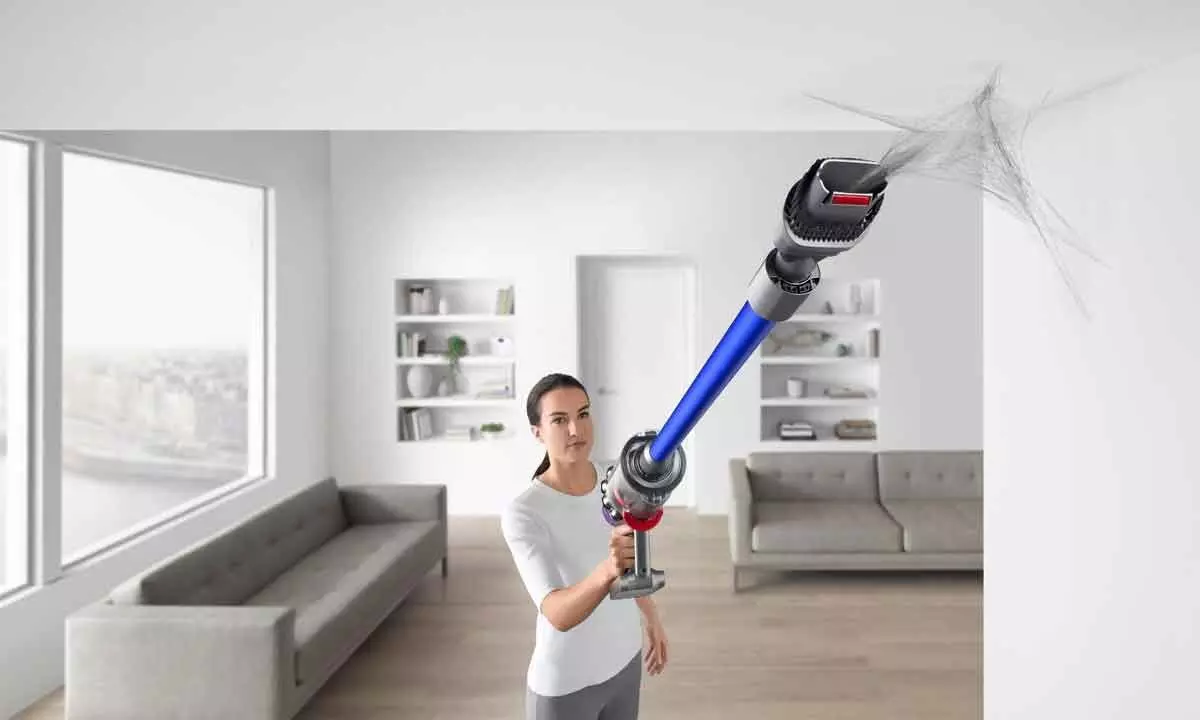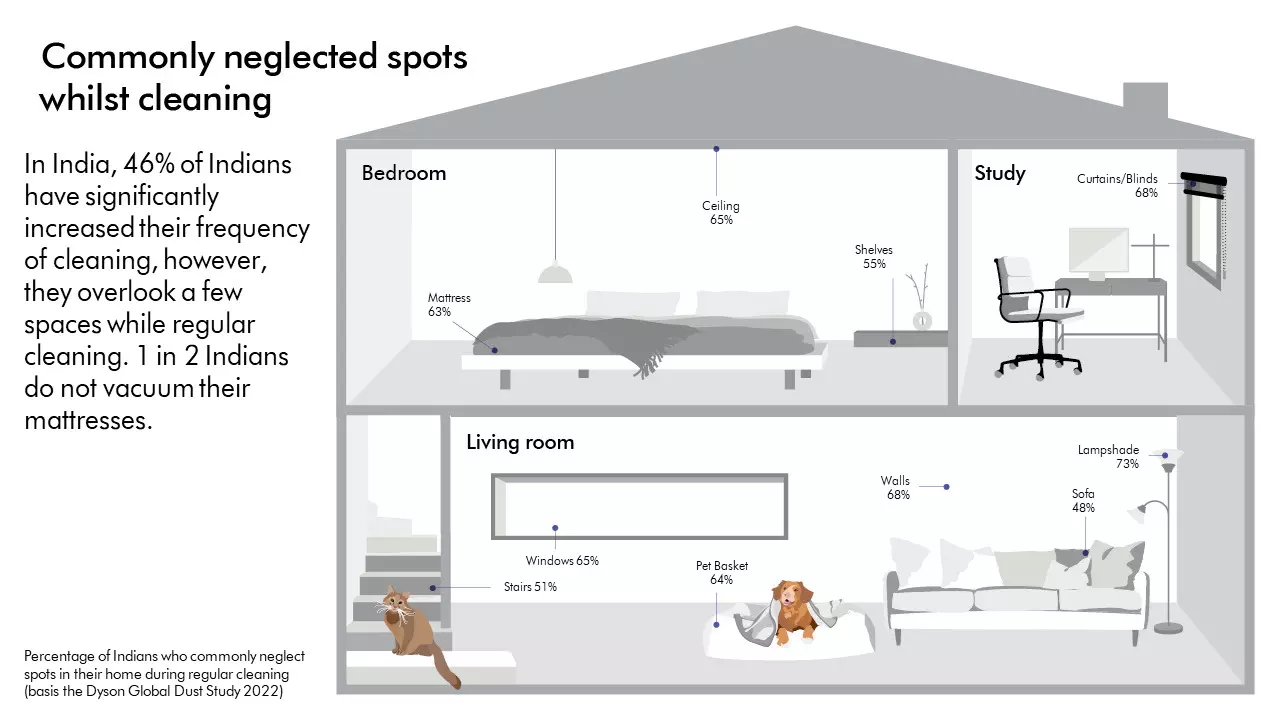Dyson reveals the most overlooked spots when cleaning

According to the Dyson Global Dust Study 20221, 46% of Indians have significantly increased their cleaning frequency and 2 in 3 Indians clean their home 5-7 times a week, the highest frequency across the Asia Pacific region.
We Indians are among those most obsessed with cleaning the spaces in which we dwell. According to the Dyson Global Dust Study 20221, 46% of Indians have significantly increased their cleaning frequency and 2 in 3 Indians clean their home 5-7 times a week, the highest frequency across the Asia Pacific region. While dust appears harmless, it is actually a complex matrix of constituents that includes dust mites, dust mite feces, bacteria, small insects and other particles. While most people vacuum their floors regularly, other rooms like mattresses, walls, ceilings, etc. have often been overlooked. Dyson Microbiology Research Scientist Dennis Mathews reveals some of the places people forget most when cleaning their homes and shares tips for deep cleaning your home.
Take a minute and think that the clean rooms we see are really clean enough. Is there any dirt that is not visible to the naked eye? Have you been covering up areas that could still be a dust hotspot after you're done with a thorough cleaning regimen? 7 out of 10 households have at least one person with a dust allergy, but 40% of Indians still consider house dust to be relatively harmless, according to the study. We often forget the particulate matter that can be there and the potential impact it could have on our health. While dust appears harmless, it is actually a complex matrix of constituents that includes dust mites, dust mite feces, bacteria, small insects and other particles. Hidden from view, they are widely found on various surfaces in your home, including floors, sofas, and beds.

A simple act like sitting on a sofa makes particles airborne and can trigger an allergic reaction. We spend about a third of our lives in our beds 2 , but the Dyson Global Dust Study 2022 1 shows Indians rarely prioritize cleaning their mattresses. It may look clean, but it can harbor millions of dust mites that affect your well-being while you sleep. While most people vacuumed their floors regularly, other rooms like mattresses, walls, ceilings, etc. were often overlooked. Thoroughly clean your home.
He says: "It is common practice to remove dust that is visible to the naked eye; However, some spots are easily overlooked. Dust has a negative impact on our health and well-being. Some neglected areas that we often fail to notice contain particulate matter, which is a major contributor to health problems. Therefore, identifying these stains and removing all dust, even microscopic ones, is essential to a clean and healthy home.
For your cleansing ritual to be truly effective, pay attention to the most neglected areas listed below:
1. Walls
Wall cleaning is something we hardly ever consider. According to the Dyson Global Dust Study 2022 1 , only 32% of Indians clean walls as part of their regular cleaning routine. However, dust on certain wall types can contribute to mold growth. Remove dust from the walls by wiping with a damp cloth, cleaning wipes or a vacuum with advanced filtration. If you're vacuuming both the ceiling and walls, start with the ceiling and then the walls to capture airborne dust that might end up on the walls, furniture, or floor below. The top-to-bottom cleaning ensures you pick up all the dust in the air as you go.
2. Mattress
Dust mites feed on skin cells, of which we lose 2-3 g per day and even more at night due to the friction of sheets. As such, mattresses can be breeding grounds for dust mites, which thrive in warm, dark, and humid places like our beds. There can be millions of dust mites on a single mattress, and each dust mite produces around 20 fecal pellets a day that contain an allergenic protein that can trigger allergic reactions.
However, according to the study, 63% of Indians do not clean or vacuum their mattress regularly. Vacuuming your mattress on both sides will help reduce the amount of dander and allergenic material on your mattress, and washing sheets and blankets at 140°F or 195°F will help break down and reduce allergens.
3. Pet beds
21% of Indians are unaware that pet allergens that cause pet allergies are found in house dust and only 36% regularly clean their pets' bedding. Like mattresses, pet beds can harbor dust mites that feed on pet hair. If possible, wash all removable covers at 140°F or 195°F. If that's not possible, use the mini power tool in a vacuum in handheld mode to fluff up and "lift" unwanted pet hair, dander, and allergens.
4. Lamps and lampshades
Dust can collect on lampshades and light fixtures, yet 73% of Indians forget to clean them, according to the study 1 . Using your vacuum's soft brush attachment with a top adapter will help you get high pitched sounds.
5. Shelves
55% of Indians do not clean their shelves regularly 1 , which is not surprising as cleaning shelves can be a tedious task. For a thorough clean, start by gently removing the contents of your shelves. Vacuum the top shelves first so you don't lose airborne dust that could settle further down. Use your vacuum's soft brush attachment with a top adapter to remove dust from high areas. Use a damp cloth to gently remove any marks or stains and allow to dry before replacing the contents of the shelves. If possible, consider removing shelves from the wall and vacuuming under furniture. If you see dust, bacteria, mold and dust mite colonies are probably already growing there.
6. Blankets
Roof structures can harbor dust and cobwebs, but 65% of Indians still miss them when cleaning their homes 1 . Vacuuming is often the easiest way to clean them. Use your vacuum's soft brush attachment to clean a larger area without damaging paint or wallpaper, and opt for a crevice tool to get into those hard-to-reach corners. A lightweight cordless vacuum is a good option for cleaning at higher elevations.
the rooms
7. Curtains and blinds
According to the Dyson Global Dust Study 2022, 68% of Indians forget to clean their curtains or blinds when cleaning their home. A lot of dust can collect there and dust mites can thrive on textiles. Be sure to vacuum them with a soft brush or wash them if possible and practical.
Top tips for a thorough cleaning
1. Clean regularly
Dust "sticks" to hard floors electrostatically, and the longer it remains on the floor, the more effort it takes to "peel" (or remove) it from the surface. Regular cleaning makes dusting easier, which applies to the whole house, not just the floors. Cleaning one spot a day (mentioned above) means you can deep clean the entire house every month. This is a highly recommended frequency for keeping your home clean without getting overwhelmed by the overwhelming task of trying to deep clean your entire home at once.
2. Clean properly
There is a tendency to use a damp cloth and/or mop to clean and kill germs in the home. However, wet cleaning with disinfectants and vacuuming fine dust are two very different jobs that need to work together for a clean home. The most common mistake is cleaning a dirty floor to create a habitat conducive to the growth of mites and mold. Removing dust and dirt from your floors before mopping is the key to a truly clean bare floor.
3. Use vacuum cleaners with advanced filtration
The main purpose of the vacuum cleaner is to remove dust and dirt from your home. A vacuum with advanced filtration is essential to ensure any baddies in your vacuum stay in your vacuum instead of being blown into your home. Look for vacuums with a five-stage filtration system to achieve 99.99% filtration of particles as small as 0.3 microns, ensuring the dust you pick up stays trapped in your vacuum and only clean air being expelled into your home.
4. Use the right tools
The Dyson Global Dust 1 study shows that while Indians believe that while vacuums are the most effective for removing household dust, only 39% of Indians use a vacuum to clean their home. 65% use a damp mop, 67% use a dry cloth, 70% use a brush and pan, with several other using traditional cleaning methods for their regular cleaning.
Sweeping and dusting can clean surfaces, but they don't remove dust from the house. They stir up the dust so that it becomes airborne again and settles elsewhere in the room. When it comes to cleaning your home, there is no magic formula. From the size of your home to the area you're cleaning, having the right vacuum and tools is important. There are different vacuum cleaners of different sizes designed to meet all kinds of cleaning needs. Every vacuum cleaner comes with a variety of tools to clean different spots. From the mini power tool that turns your stick vacuum into a handheld vacuum, to the mattress (upholstery) tool designed to remove dust and allergens from fabrics, to the quick-release crevice tool that helps get into tight spaces reach.

Aucun commentaire:
Enregistrer un commentaire